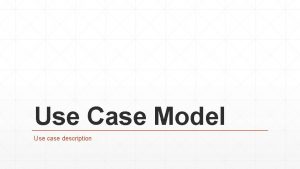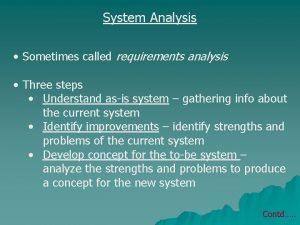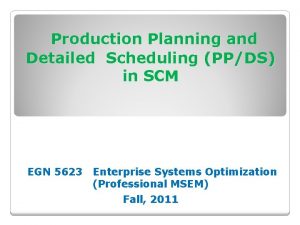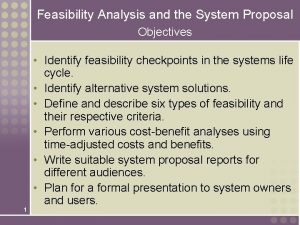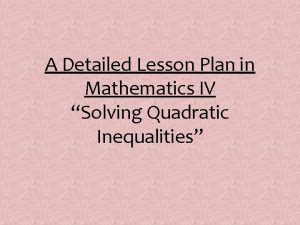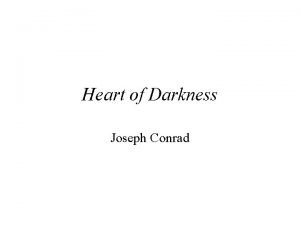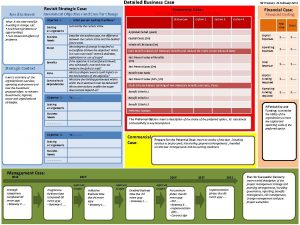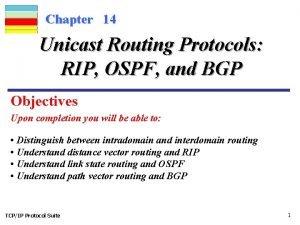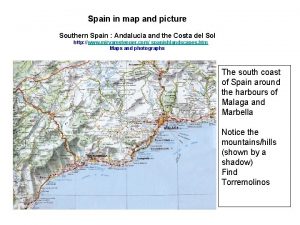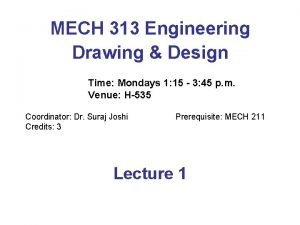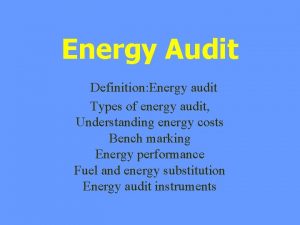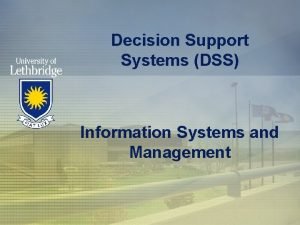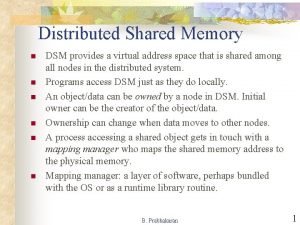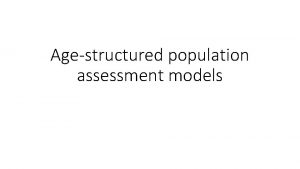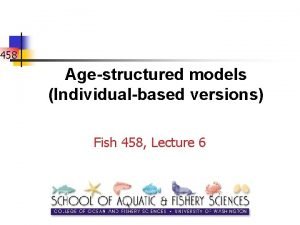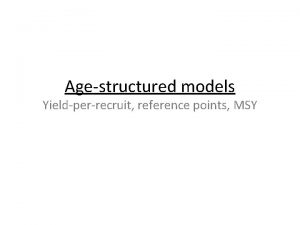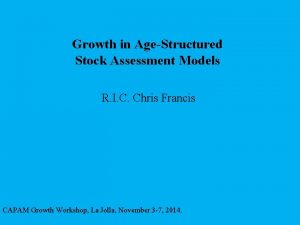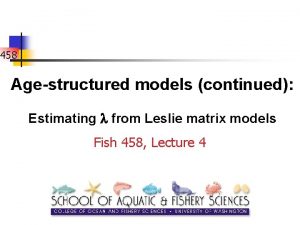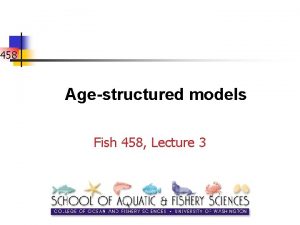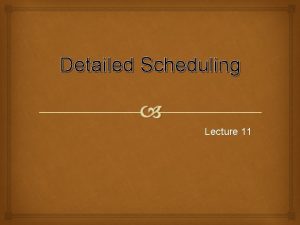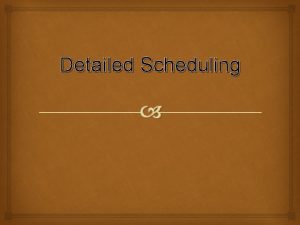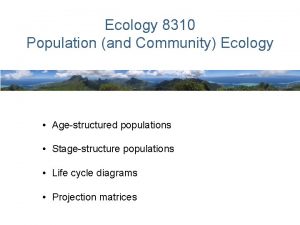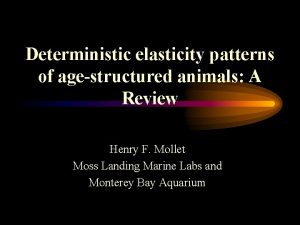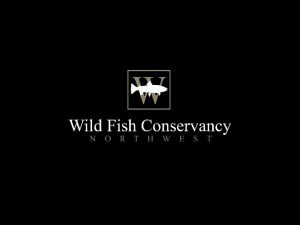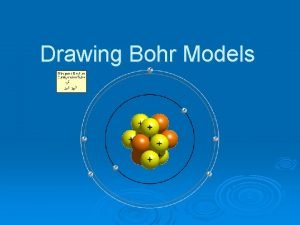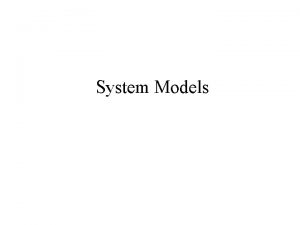Agestructured models An agestructured model is a detailed


































- Slides: 34

Age-structured models An age-structured model is a detailed model of the number of individuals of each age in each year The number of births in each year The number of deaths each year Natural mortality Human mortality (fishing/logging/accidental, etc. ) Somatic growth Immigration and emigration

Age-structured fisheries model Sequence of events Start of the year Spawning Fishing mortality Natural mortality Assume no immigration or emigration (a closed population) Number of fish of age a in year t

Age structure for year 1

Age 1, year 1 numbers Number of fish In the youngest age group Starting recruitment in the model. The number R 0 determines whether the population will be big or small In the first year

Age 2, year 1 numbers Age-1 fish in the previous year (t=0) become age-2 fish this year (t=1), but some are caught by fishing, and some die naturally Number of age-2 fish in year 1 Vulnerability [0 -1]: how easily are age-1 fish caught, which is a combination of gear type and fishing area Natural survival of age-1 fish [0 -1] Number of age-1 fish in year 0 Exploitation rate [0 -1]: how much fishing was there in year 0?

But wait. . . We don’t know numbers or fishing mortality in year 0 We will assume the population was in equilibrium in all years before year 1, then we can proceed, given these assumptions. . . Numbers of age 1 fish will be the same in every previous year (R 0) Fishing mortality will be the same in previous years Natural survival will be the same in previous years

3 Basic age-structured model. xlsx sheet: “First yr”

Therefore age 2, year 1 numbers Number of age-2 fish in year 1 Vulnerability between 0 and 1 (how easily are age 1 fish caught) Natural survival of age-1 fish Number of age-1 fish in year 1 is R 0 Exploitation rate in year 1 Key assumption: the population is in equilibrium in year 1 and all previous years (same R 0, same ut)

Continue to all ages in first year Number of age a+1 in year 1 Vulnerability between 0 and 1 (how easily are age 1 fish caught) Natural survival of age a fish Exploitation rate in year 1 Number of age a fish in year 1 For all ages up to some maximum age n

Plus group: what happens at age n? • It is convenient to stop keeping track of fish at some particular age a = n called the plus group • Fish accumulate in this age group • Vulnerability vn, fishing mortality ut, and natural survival sn are all assumed to be constant in the plus group (here also assumed equal to values for age n – 1) • Total fish in this group are:

Plus group in starting year t=1

Side note: solving geometric series For your interest only

3 basic age-structured model. xlsx sheet: plus group formula

Summary: age structure year 1 Starting recruitment Vulnerability depends on age Exploitation rate depends on year Natural survival rate Numbers in plus group age n

Age structure for future years (years 2, 3, . . . )

Recruitment in future years Recruitment in the first year is some fixed value R 0. But after year 1, recruitment Rt+1 might be reduced if the population declines. Recruitment is a function of previous year population size, as follows: Fecundity (egg production) Egg production Recruitment is some function of egg production e. g. Beverton-Holt The stock-recruit relationship, more on this later

Ages 1 to n in future years Fish of age a in year t become fish of age a+1 in the next year, t+1. Not all survive because some succumb to fishing mortality and natural mortality. Vulnerability Exploitation rate Natural survival rate

Plus group in future years The plus group in the next year is the plus group in previous year Nn, t plus fish of age n– 1 the previous year Nn– 1, t all multiplied by total survival Vulnerability Exploitation rate Natural survival rate

Catch weight in all years Total catch weight is a function of fishing mortality (how hard we are fishing), vulnerability (the probability fish of each age are caught), how many fish there are, and the weight of the fish Vulnerability Total catch weight Exploitation rate Weight at age (I know, “mass”)

Summary: age structure future years Fecundity (egg production) Egg production Recruitment is a function of egg production e. g. Beverton-Holt Recruitment Vulnerability Ages between 1 and n Exploitation rate Natural survival rate The plus group All individuals identical above the plus group age Catch weight Weight at age

3 basic age-structured model. xlsx sheet: age structure template (practice filling in the cells!)

3 basic age-structured model. xlsx sheet: age structure complete (final solution)

Some assumptions • No immigration or emigration • Parameters such as v, s, w, f do not change over time • Vulnerability v and weight w not affected by fishing • Parameters v, s, w, f are the same for all ages in the plus group • Sexes are identical

Recruitment in future years Delving into g(Et) The Beverton-Holt function

Desirable recruitment properties • Definition: in the absence of fishing, there will be R 0 recruits, and S 0 spawners (producing E 0 eggs) • If the population is less than S 0, then recruitment will be less than R 0 • If the population is at S=E=0, there will be R=0 recruits • If the population is at a fraction b of S 0, i. e. S=b. S 0 then R>b. R 0 (when the population is below S 0 it will recover instead of dwindling to extinction. )

Recruitment Spawners -> recruits -> spawners Start point Spawners (egg output) 3 Basic age-structured model. xlsx sheet: Spiderweb

Recruitment Beverton-Holt stock-recruit function Recruitment Spawners (egg output) Is the curve flatter or steeper for different values of α and β? Intuition difficult. 3 Basic age-structured model. xlsx sheet: Beverton-Holt

Beverton-Holt • What is unfished recruitment (R 0) and unfished spawning output (E 0)? • We want R 0 recruits to result in enough spawners to produce E 0 eggs, and we also want the Beverton-Holt equation to ensure that E 0 eggs will produce R 0 recruits • Solution: steepness parameterization

What is steepness (h)? Definition: the fraction of unfished recruitment obtained when egg production is at 20% of unfished levels R 0 unfished recruitment 0. 95 0. 7 0. 5 0. 3 E 0 unfished egg production 20% of unfished egg production

Beverton-Holt with steepness (h) R 0 0. 95 Spawners-per-recruit, unexploited with ut=0. See next slide. 0. 7 0. 5 0. 3 E 0 or SSB 0 Mace PM & Doonan IJ (1988) A generalised bioeconomic simulation model for fish population dynamics. New Zealand Fisheries Assessment Research Document 88/4. Fisheries Research Centre, MAFFish, POB 297, Wellington, NZ. Derivation is given in “ 3 Beverton-Holt steepness handout. pdf”

SPR 0 (spawners per recruit) How many spawners (eggs) would one recruit produce over its lifetime, on average, in the absence of fishing? A single recruit Natural survival at age a Plus group Fecundity at age a

3 basic age-structured model. xlsx sheet: Beverton-Holt h 3 Beverton-Holt steepness handout. pdf

Review: calculating Beverton-Holt parameters To find lifetime spawners produced by one recruit Natural survival at age a Unfished recruitment Steepness parameter Fecundity at age a

3 basic age-structured model. xlsx sheet: Full derivation
 How to calculate kloc in cocomo model
How to calculate kloc in cocomo model Detailed cocomo model example
Detailed cocomo model example Difference between modal and semi modal verbs
Difference between modal and semi modal verbs Use-case model
Use-case model Analysis is sometimes called
Analysis is sometimes called Detailed reading examples
Detailed reading examples Production planning and detailed scheduling services
Production planning and detailed scheduling services Detailed lesson plan in hairdressing
Detailed lesson plan in hairdressing Objectives of proposed system
Objectives of proposed system Elizabeth bishop quotes leaving cert
Elizabeth bishop quotes leaving cert Detailed routing
Detailed routing Cross halving joint drawing
Cross halving joint drawing Detailed lesson plan about quadratic equation
Detailed lesson plan about quadratic equation Detailed design in software engineering
Detailed design in software engineering Detail assembly drawing
Detail assembly drawing Whited sepulchre heart of darkness
Whited sepulchre heart of darkness Function oriented design in software engineering
Function oriented design in software engineering Detailed business case
Detailed business case Write a detailed note on unicast routing protocols
Write a detailed note on unicast routing protocols Example of detail drawing
Example of detail drawing Engineering drawing code
Engineering drawing code Detailed map of southern spain
Detailed map of southern spain Solid in engineering drawing
Solid in engineering drawing How to write a riddle
How to write a riddle First cut detailed sequence diagram
First cut detailed sequence diagram Detailed comprehension
Detailed comprehension Energy audit and its types
Energy audit and its types Characteristics of dss in mis
Characteristics of dss in mis Cima membership application
Cima membership application Uml book
Uml book Range cards and sector sketches
Range cards and sector sketches Detailed lesson plan about coral reefs
Detailed lesson plan about coral reefs Distributed shared memory
Distributed shared memory Model netics
Model netics Klm examples hci
Klm examples hci



